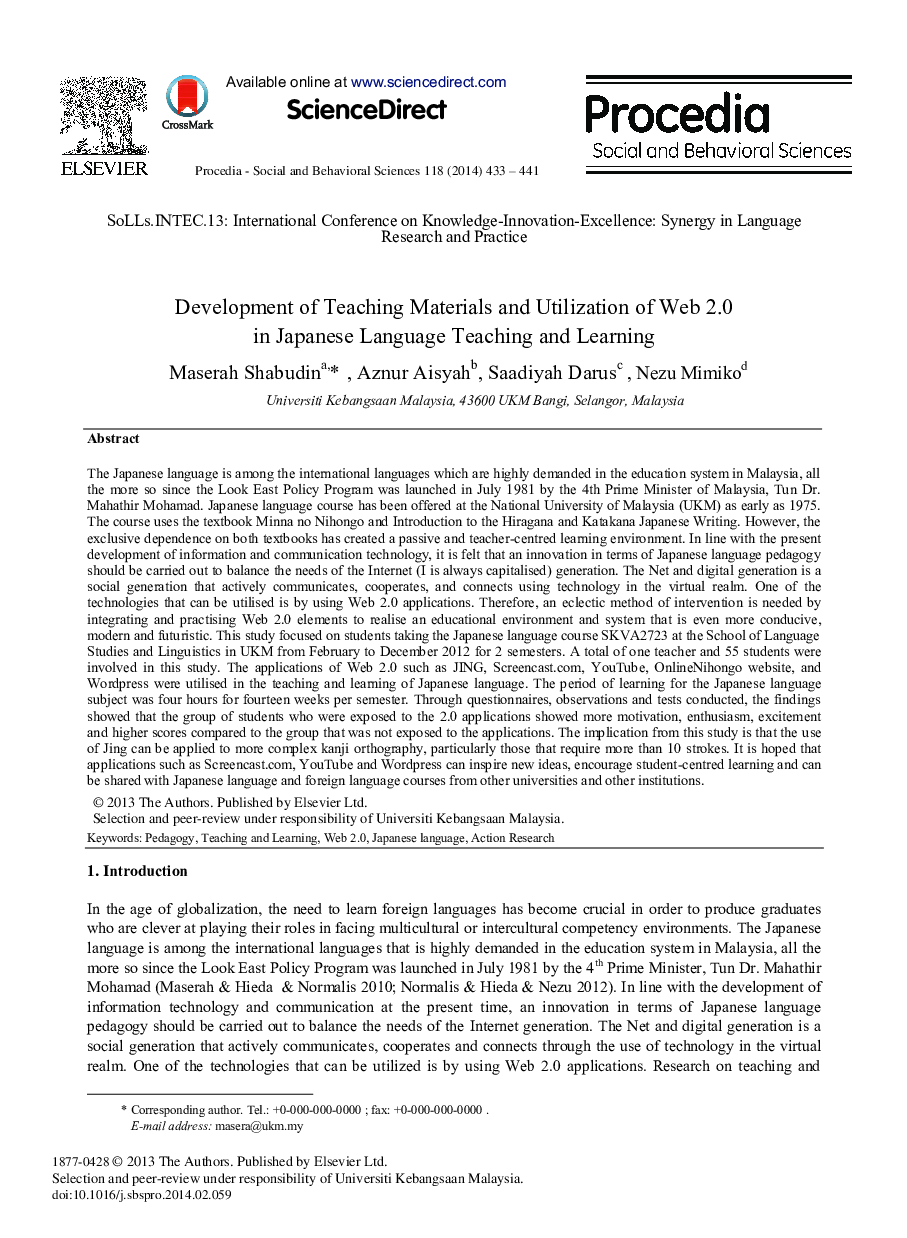| کد مقاله | کد نشریه | سال انتشار | مقاله انگلیسی | نسخه تمام متن |
|---|---|---|---|---|
| 1115760 | 1488441 | 2014 | 9 صفحه PDF | دانلود رایگان |
عنوان انگلیسی مقاله ISI
Development of Teaching Materials and Utilization of Web 2.0 in Japanese Language Teaching and Learning
ترجمه فارسی عنوان
توسعه مواد آموزشی و استفاده از وب 2.0 در آموزش و یادگیری زبان ژاپنی
دانلود مقاله + سفارش ترجمه
دانلود مقاله ISI انگلیسی
رایگان برای ایرانیان
کلمات کلیدی
آموزش و پرورش، تدریس و یادگیری، وب 2.0، زبان ژاپنی، تحقیق عملی،
موضوعات مرتبط
علوم انسانی و اجتماعی
علوم انسانی و هنر
هنر و علوم انسانی (عمومی)
چکیده انگلیسی
The Japanese language is among the international languages which are highly demanded in the education system in Malaysia, all the more so since the Look East Policy Program was launched in July 1981 by the 4th Prime Minister of Malaysia, Tun Dr. Mahathir Mohamad. Japanese language course has been offered at the National University of Malaysia (UKM) as early as 1975. The course uses the textbook Minna no Nihongo and Introduction to the Hiragana and Katakana Japanese Writing. However, the exclusive dependence on both textbooks has created a passive and teacher-centred learning environment. In line with the present development of information and communication technology, it is felt that an innovation in terms of Japanese language pedagogy should be carried out to balance the needs of the Internet (I is always capitalised) generation. The Net and digital generation is a social generation that actively communicates, cooperates, and connects using technology in the virtual realm. One of the technologies that can be utilised is by using Web 2.0 applications. Therefore, an eclectic method of intervention is needed by integrating and practising Web 2.0 elements to realise an educational environment and system that is even more conducive, modern and futuristic. This study focused on students taking the Japanese language course SKVA2723 at the School of Language Studies and Linguistics in UKM from February to December 2012 for 2 semesters. A total of one teacher and 55 students were involved in this study. The applications of Web 2.0 such as JING, Screencast.com, YouTube, OnlineNihongo website, and Wordpress were utilised in the teaching and learning of Japanese language. The period of learning for the Japanese language subject was four hours for fourteen weeks per semester. Through questionnaires, observations and tests conducted, the findings showed that the group of students who were exposed to the 2.0 applications showed more motivation, enthusiasm, excitement and higher scores compared to the group that was not exposed to the applications. The implication from this study is that the use of Jing can be applied to more complex kanji orthography, particularly those that require more than 10 strokes. It is hoped that applications such as Screencast.com, YouTube and Wordpress can inspire new ideas, encourage student-centred learning and can be shared with Japanese language and foreign language courses from other universities and other institutions.
ناشر
Database: Elsevier - ScienceDirect (ساینس دایرکت)
Journal: Procedia - Social and Behavioral Sciences - Volume 118, 19 March 2014, Pages 433-441
Journal: Procedia - Social and Behavioral Sciences - Volume 118, 19 March 2014, Pages 433-441
نویسندگان
Maserah Shabudin, Aznur Aisyah, Saadiyah Darus, Nezu Mimiko,
